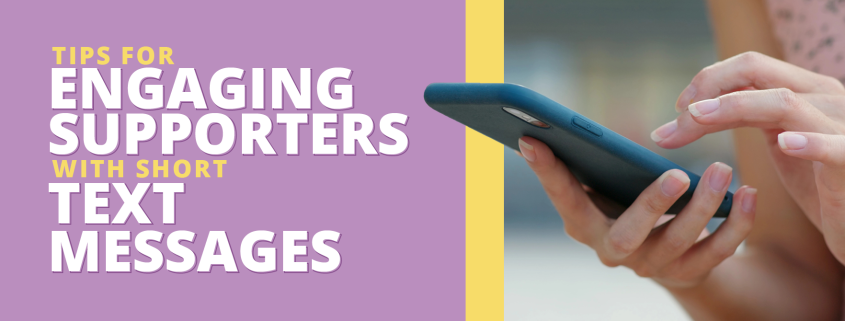5 Tips for Engaging Supporters with Short Text Messages
As a nonprofit professional, you know that every donor counts. That’s why you employ a variety of strategies, from email newsletters to fundraising events, to keep them invested in your mission. Donors give to your organization because they’re passionate and believe in your cause. However, retaining them can be challenging. According to Bloomerang, the average donor retention rate for nonprofits hovers around 45%.
To nurture authentic, lasting relationships with your donors, you need to leverage a channel that’s built for personal, one-on-one communication: text messaging. In fact, according to Tatango, over 20% of donations come from text messages and nonprofits earn an average of $5 for every $1 spent on text messaging.
If your nonprofit is ready to make the most of this innovative and impactful channel, use these tips to construct your strategy.
1. Choose comprehensive nonprofit text messaging software.
To get and stay in touch with your nonprofit’s community, you need to equip your team with the tools it needs to send regular, effective messages. That’s where nonprofit text messaging software comes in. When used as part of an omnichannel campaign, nonprofits can see an increased return on investment across all channels.
To find a solution that fits your nonprofit’s needs, look out for these key features:
- A2P (Application to Person) messaging. Once supporters have opted into receiving text messages from your nonprofit, use A2P messaging to send mass texts that can reach everyone in your contact list at once. This way, you can ensure that you’re not leaving any important audience members out of your communications.
- Text-to-donate. Using your text platform, you should be able to create a custom keyword that donors can text to make a gift. They’ll then receive a link to your donation form, which they can conveniently fill out on their mobile device.
- Secure sending. Donors need to know that their privacy and data are protected. When choosing the right nonprofit text messaging software, ask questions about the security of the platform. Your best bet is to find a platform that is SOC-2 compliant, the highest level of security.
- Segmentation. Send only the most relevant messages to your supporters through segmentation. Group them by factors such as location, past donation history, or event attendance to make each recipient feel valued and strengthen your connection with them.
- A/B testing. Your supporters will tell you how they want your organization to communicate with them. All you have to do is listen. Your text platform should allow you to use A/B testing in your campaigns to learn more about supporters’ preferences.
After you’ve found a suitable solution for your nonprofit, put together a subscriber list, ensuring that you receive prior consent to remain compliant with the Telephone Consumer Protection Act (TCPA).
2. Personalize each text message.
When donors receive text messages from your nonprofit, they want to feel as though you’re addressing them individually, not as a generic source of revenue. While your text messages should be short, you should still tailor them to the recipient.
Segment your subscriber list and reference relevant details from your database when sending messages, such as:
- Preferred name
- Location
- Engagement history
- Past giving
- Programs or areas of interest
Use your platform to schedule text messages at times when your supporters are most likely to see them, such as afternoons or on weekends. By monitoring opt-outs, unsubscribes, open rates, click rates, and other key metrics, you can learn the right cadence and frequency for texting your supporters.
3. Incorporate attention-grabbing visual content.
Your nonprofit’s supporters get involved because they want to play a role in your impact on the community. Incorporate images, videos, and GIFs in your text messages to help them visualize their impact and retain their support.
For example, you could make your text content more eye-catching by including:
- Images of beneficiaries
- Snapshots of your volunteers hard at work
- Emojis relevant to your mission
- Infographics that illustrate the importance of your cause
Make donors feel empowered to join in on the difference you’re making by sharing uplifting, inspiring visual content and highlighting the role they can play in it all.
4. Include only one call to action per message.
Your nonprofit’s text messages should be short and simple. This means that you shouldn’t overwhelm your audience with too many calls to action (CTAs) per message.
Follow these best practices to inspire your recipients to take action:
- Only include one CTA per text message.
- Add a sense of urgency to your CTAs.
- Share a link to a relevant landing page.
Whether you’re encouraging supporters to make a donation or sign up to volunteer, be sure that your page is mobile-friendly so they can take action directly from their phones.
5. Share a variety of engagement opportunities.
When you text your friends or family members, chances are you’re not sending them the same type of message over and over again. The same applies to your nonprofit’s text messages.
Keep your communications lively and interesting by sharing a variety of engagement opportunities, such as:
- Signing up to volunteer.
- Registering for an upcoming fundraising event.
- Becoming a peer-to-peer fundraising participant.
- Joining a social media community.
According to Double the Donation, 47% of donors also support nonprofit causes through online raffles or sweepstakes, 45% purchase from an online store benefiting a nonprofit, and 24% give through online auctions. The more opportunities you put in front of your supporters, the more likely they are to engage in the ways that best appeal to them.
Throughout your nonprofit text messaging campaign, keep an eye on metrics such as your open rate and click-through rate to measure the effectiveness of your approach and adjust your tactics as needed. Over time, you’ll be able to share news, inspire action, and retain more donors through text messaging.




